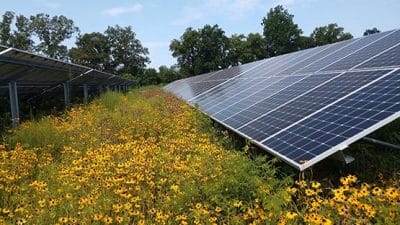
The video begins with a black screen, framing the words of pop megastar Pharrell Williams: “The people I needed to make my dream a reality … I found in Virginia Beach.”
Video: youtu.be/
Against an overhead shot of a surfer paddling out, Williams muses on the meaning of waves.
“You know, there’s something interesting about waves,” Williams says over the opening bars of a melody. “Most people think about water, but the real magic of waves is the energy, that beautiful energy that when harnessed has the potential to power incredible things. This is a story about my hometown, Virginia Beach, and the incredible potential of this place and its people. It’s like a wave — a wave that’s ready to power the future.”
The beat drops, and over the next two minutes and 15 seconds, the singer and producer describes a project aimed at transforming an oceanfront site that’s pivotal for Virginia Beach’s past and future. He remembers about the central role that the futuristic facade of the Dome, a former music venue, played when he was growing up, and how “it made my young imagination run wild.” Images of the past give way to a vision of the future, as Williams begins laying down the pitch for The Wave, a 10-acre mixed-use development on the Dome’s former site that blends retail, housing, entertainment — including, yes, a new music venue — all surrounding a surf park where beginners can learn and experienced surfers can perfect their art even on the calmest days.
If you can’t tell, The Wave is a big deal. And it started at Virginia Tech, with Alec Yuzhbabenko’s senior thesis.
Yuzhbabenko (architecture ’15) was born and raised in Odessa, Ukraine, on the coast of the Black Sea. His father was a merchant marine and an electrical engineer, whose job took the family to Mobile, Alabama, on the Gulf Coast, when Yuzhbabenko was 8 years old. Two years later the family moved to Virginia Beach, Virginia. Through all the moves, Yuzhbabenko found a constant in being near water. The family remained in Virginia Beach, and Yuzhbabenko adopted the coastal city as his hometown.
He developed a passion for skateboarding, but after he suffered a severe ankle break, he shifted to the lower-impact sport of surfing. Besides board sports, Yuzhbabenko also pursued drawing and painting, a hobby acquired from his mother. After a construction class in high school, he fused his passion for art with building and became interested in architecture, leading him to apply to Virginia Tech’s College of Architecture and Urban Studies. He was accepted and moved inland to Blacksburg, where during the next five years he found a like-minded community with the Virginia Tech Surf Club. He and his friends in the club watched surf movies, hosted competitions and booked surf trips to Puerto Rico and elsewhere.
Yuzhbabenko worked a variety of internships during his years at Virginia Tech, one of which almost made him want to quit architecture to pursue construction instead. In the spring of 2014, however, he interned at Skidmore, Owings & Merrill LLP, a Chicago-based firm that is one of the largest and most influential in the country. The experience was transformative.
“It opened my eyes to a new world of what architecture really is,” Yuzhbabenko said. “I was helping develop master plans for cities in China. We were working on a skyscraper competition in Dubai. I finally saw architecture’s true role in society and its amazing influence on context, space, and human interaction. It was a breath of fresh air; I had a new energy to what I perceived my work to be, and what it could be.”
His internship the following summer revolved around a collaborative research project, where he took what he learned in Chicago and helped design the “Central Beach Parkway,” a master plan of an area at the Virginia Beach Oceanfront. The focused research in that area led directly to Yuzhbabenko’s senior thesis. He decided to take a vacant lot within the masterplan — a 10-acre parcel that had once been home to the Dome music venue but was now a parking lot — and project his own ideas into the space.
“I wanted to create a project for my thesis where I fused my profession and education with my hobbies and what I was passionate about,” Yuzhbabenko said. “I was building off everything I learned through my childhood. I used my experience with skate parks and the sensitivity to the ocean with surfing. I used the creative side of art with my construction interests.”
Inspired by the challenge of Virginia Beach’s inconsistent waves, Yuzhbabenko reached out to companies who had been exploring manmade waves. He fused that central feature with the European architecture of his childhood in Ukraine, in which housing units are built in a square around a courtyard of green space that acts as a public gathering place. His driving goal was to reverse the outward flow to suburbs and catalyze the nearby beachfront into a live/work/play environment by making the site a destination, even in the off-season.
Yuzhbabenko’s thesis was eventually nominated and became a finalist for the Pella Prize, which is selected by students and faculty. His project did not win, but it provided him a chance to synthesize his varied interests in a way that could change the landscape of Virginia Beach. He captured his designs and ideas in a book and placed it on his shelf.
Upon graduation, Yuzhbabenko was offered jobs in California, Chicago, and Washington, D.C. He decided to come back home and take a job in Virginia Beach.
“I became so invested in the place where I grew up that I felt an obligation to come back and contribute to the community that raised me and really invested into my education,” Yuzhbabenko said. “I felt like I had an obligation to give back what I had learned at Virginia Tech.”
uzhbabenko was in the region when the city of Virginia Beach issued a request for proposals to develop that same 10-acre site that had been the focus of his senior thesis. A developer approached his firm looking for a partner on its idea for a mixed-use development. Yuzhbabenko’s boss called him into a meeting and told the executives there that the same site had been the subject of his senior thesis at Virginia Tech. Yuzhbabenko pulled his old project off the shelf and presented it to the group. He won them over.
Yuzhbabenko had just two weeks to rework his project in time for the city’s deadline. He redesigned some aspects from his thesis project to incorporate features requested by the city, presented it to the jury, and was selected as the preferred concept.
“The city saw passion from the team, but also something rooted in the culture of Virginia Beach,” Yuzhbabenko said. “It wasn’t just another development done somewhere else being placed on the site for this project. They felt like it was the first proposal that really meant something, not only for residents of Virginia Beach but also its culture, and to attract more people to come to experience that culture in a more consistent way.”
In the year since the city’s selection of Yuzhbabenko’s plan, the team has continued to tweak it, presenting it to local civic groups and gathering public input. Along the way, Pharrell Williams got a look at the plans and took an interest, particularly in the entertainment aspect.
The pre-development agreement is set to be signed this summer. At that point, the firm will develop technical drawings. It will negotiate a price with the city and — fingers crossed — sign a development deal by the end of the year. Yuzhbabenko hopes to break ground by this time next year, with completion scheduled for 2022.
The surf park and surrounding development combine many of the things Yuzhbabenko loves most in life, but it’s the Ut Prosim (That I May Serve) ethic emphasized at Virginia Tech that gives it meaning.
“I feel like I’m part of the community here where I grew up, so it wasn’t just creating something as a dream, but really contributing to the culture of the past while looking toward the future,” Yuzhbabenko said. “The whole reason I came back to this area was to give back. I’m not in a position to give back through monetary means; the way I’m able to give back is through design.”










